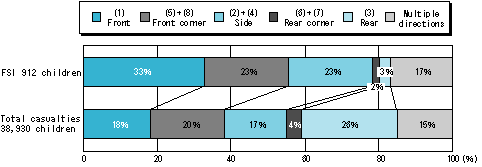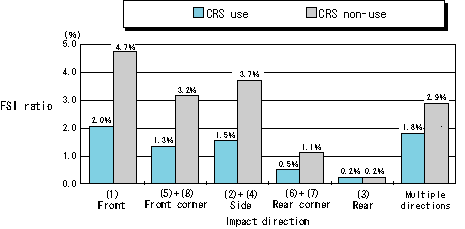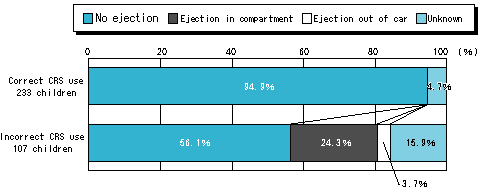 |
||||
|
|||||||
 |
| Vehicle collisions occur in diverse patterns with the impact coming from the front in the case of frontal collisions, from the rear in the case of rear-end collisions, and from a side in the cases like angle collisions at intersections. Figure 4 shows the breakdown of FSI and total casualties by impact direction. Among total casualties, the largest portion (26%) was registered with impacts from the rear. Among FSI casualties, however, a large majority received an impact from the front (33%), from a front corner (23%), and from a side (23%). Only a small percentage of FSI casualties received an impact from the rear (3%). Evidently rear-end collisions are more likely to result in slight injuries but rarely in serious or fatal injuries. A large majority of fatal and serious injuries occur in front and side collisions. |
 Fig. 4 Percentage of child casualties by impact direction, 1996-2000 Note: The population - passenger car occupants up to 5 years old.  Table 1 Data employed in Figure 4  |
| To examine the effects of CRS in relation to various impact directions, Figure 5 compares FSI ratios between CRS use and non-use according to impact direction. Whether or not the child is seated in a CRS, a higher FSI ratio was recorded from collisions with front and side impacts and the lowest FSI ratio was found in collisions with rear impacts. For the protection of small children, focus must be on front and side collisions. The data in Figure 5 also verify the FSI-reducing effect of CRS in almost all impact directions. Even in front and side collisions, CRS can reduce the FSI risks of small children. |
 Fig. 5 CRS effects according to the direction of collision, 1996-2000 Note: The population - passenger car occupants up to 5 years old.  Table 2 Data employed in Figure 5  |
 |
| 5.1. Ejection from CRS Positions |
| Although CRSs can be consider to have a child protection effect, our June 2001 study of police records confirmed that the correct use of CRS is an important precondition for realizing the CRSpotential. We examined the available police records of 554 accident cases where CRS-seated children were injured. Of these, 214 cases were excluded because the police records failed to clarify whether or not the CRS had been operated correctly. The remaining 340 cases were divided into 233 correct cases of CRS use (correct CRS use group) and 107 incorrect cases (incorrect CRS use group). As shown in Figure 6, a total of 31 injured children were found ejected from their CRS positions -- 27 landing within the passenger compartment and 4 thrown out of the car. Of these 31 ejection cases, 30 (28.0%) occurred in the incorrect CRS use group, while only one (0.4%) was recorded from the correct CRS use group. Since the "correct" and "incorrect" use of CRS was based on the personal judgment of police officers on the site, we selected as incorrect uses only plainly erroneous cases such as the seating of the child in a wrong direction and the failure to securely install the CRS on the car seat. |
 Fig. 6 Incidence of child ejection from CRS position Note: Excluding 214 cases with unclear data on correct/incorrect CRS use. |
Table 3 Data employed in Figure 6  |
| 5.2. CRS and Injury Patterns |
| To further understand the risks of incorrect CRS use, we studied another set of accident data from the perspective of the injury receiving parts of the human body and injury inflicting objects. Of the total 273 cases studied, in 126 cases the child received injury from the CRS itself and in 147 cases the child was injured by an object existing around the car seat (Figure 7). In the first group where the child was injured by the CRS, there is a relatively low incidence of injury to the head and face or in other words a low incidence of fatal injury. In contrast, where the child was injured by an object around the car seat, there is a much higher incidence of head/face injury. The implication of an injury done by the CRS is that the child was kept restrained inside the CRS during the vehicle collision. On the other hand an injury inflicted by an object around the car seat suggests either that the child was ejected from the CRS or that the CRS with the child seated on it was displaced from its installation position. In both cases the child was injured due to the incorrect use of the CRS. The data thus indicate that the risks of a serious or fatal injury, often injury to the head, can be reduced by properly installing a CRS on a car seat and by properly securing the child in the CRS. |

Fig. 7 Injury inflicting objects and injured parts of child body Table 4 Data employed in Figure 7 |
 |
| UP |
Institute for Traffic Accident Research and Data Analysis (ITARDA) |